Feeling overwhelmed by your garden? 11 easy, practical solutions
It’s easy to feel overwhelmed by your garden, especially in late spring when plants and weeds are bursting into growth. The gardening to-do list at this time of year can seem endless.
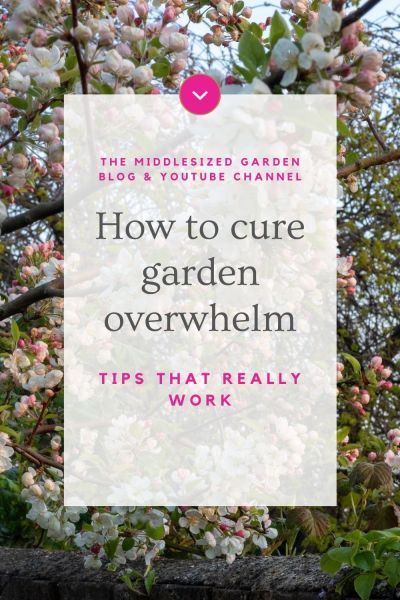
Of course, the first step is to make a list. But when it gets too long, that is overwhelming in itself.
So it is what you do with your list that counts. Having just woken up myself at 3am wondering how I am going to manage the advancing mess outside, these are the tips that have worked for me.
- Chunk it down by tasks – divide the tasks into easy-to-do chunks.
- Chunk it down by time – set your timer for 15 minute spells
- Chunk it down by garden area – have some low maintenance borders and zones
- Grow shrubs, perennials and trees instead of annuals and bedding. Topiary is particularly effective.
- Minimise pots. Have one or two large pots instead of lots of small ones. Or no pots!
- Designate wilder, low maintenance areas as ‘wild’, but find out what you do still need to do.
- No task is too small. If you see a weed in passing, pull it out then. Don’t wait until you have time to weed the whole border.
- Install an outdoor tap or taps in a convenient place for watering.
- Do a daily inspection. With a notebook or without.
- Get help (but be aware of the constraints)
- Let go of the concept of perfection. Even great gardens are never perfect.

Topiary is a highly effective way of adding wow factor to the garden without adding too much work. These trees need specialist trimming once a year, but are otherwise maintenance-free.
Chunk it down by task…
The first step is a favourite counselling and coaching maxim: ‘chunk it down’. That means cutting your task or list into manageable chunks. only do one chunk at a time. Don’t try to do them all.
It can be summed up by Anne Lamott’s Bird by Bird, a book on ‘writing and life’. When her 10 year old brother had to write a big report on the birds he’d seen in the garden, he didn’t know how to start or what to do. ‘Do it bird by bird,’ their father advised him. Anne has now turned the saying into her best-selling book on how to write. It applies equally to gardening. (Note that links to Amazon are affiliate, see disclosure).
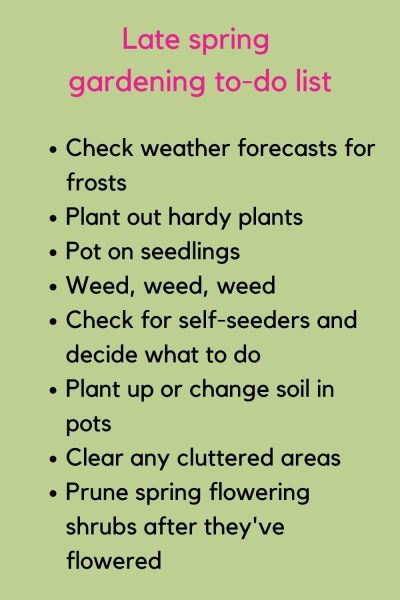
This gardening to-do list doesn’t even include the regular jobs, such as ‘mow the lawn’ which is usually weekly by now.
You can ‘chunk it down’ by task. Pick just one task to complete in any one day. For example, I recently chose to clear my ‘difficult shady corner’ of the clutter it had accumulated. Once I’d done, I finished gardening for the day. I felt much less overwhelmed and more in control.
Or chunk it down by time…
If you feel overwhelmed by your garden, this is my favourite tip. Set your timer for 15 minutes. Then spend exactly 15 minutes on one task. Walk away when the timer goes off. If the task isn’t complete, repeat again, either later that day or on another day.
This is also a good tip for avoiding back or knee pain in the garden. Use the 15 minute timer to stop yourself from doing any one task for too long. If you do 15 minutes of potting up seedlings, then 15 minutes of weeding (kneeling or bending), then you should avoid doing either for too long.
Everyone has fifteen minutes – so this is a tip that works particularly well if it’s a job you hate. It’s also a very efficient use of time because there are no breaks in the 15 minutes. If you set aside, for example, two hours for a task, you’ll probably get distracted, have a coffee, receive a phone call… you could get to the end of the two hours without having finished.
Yet I often find that even a mammoth task, such as the once-a-year tidying of the potting shed, breaks down into just three or four 15 minute chunks. Have a coffee break between 15 minute periods or do something else.
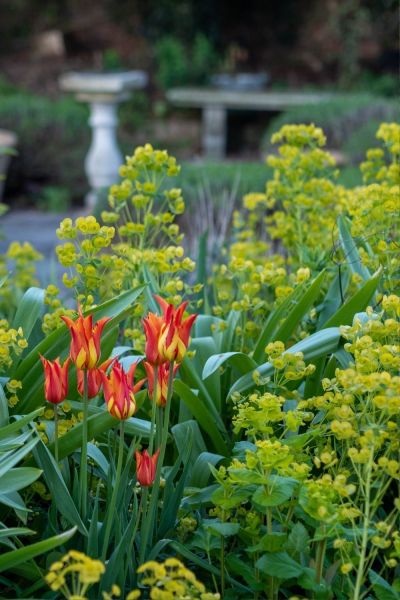
While weeding in spring, look out for self-seeding plants because they can add so much to the garden. Here some stripey Ballerina Tulips are offset by the vivid green of Euphorbia ‘Robbiae’, a vigorous self-seeder in my garden.
Chunk it down by garden area
One of the most helpful things we did when we re-designed the garden was to make some areas deliberately low maintenance. For example, one was our shady borders with easy-to-care for shrubs and trees. These don’t require constant dividing, dead heading or even fertilising. Most require just a once-a-year prune.
We have one big central sunny border. This is where I concentrate my active gardening, with dahlias, some annuals, self-seeders, roses and more.
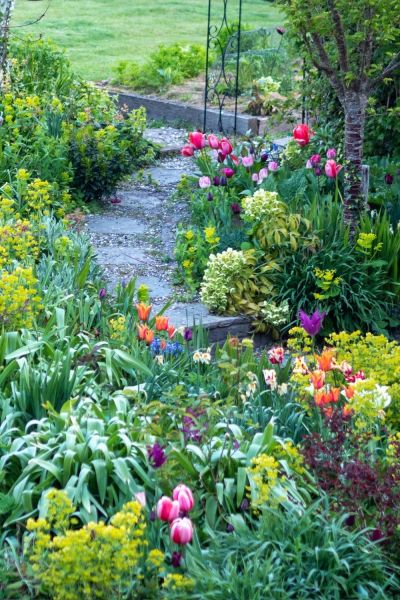
I have allocated the border in the foreground for higher maintenance gardening. This is where I plant dahlias, annuals, roses and other plants that need more attention than most shrubs and trees.
And when we decided to have plants in the central area of our parterre, we decided that one kind of plant would be easier than four little borders. We chose easy-care lavender. This just requires cutting once a year, in August. It doesn’t need any other maintenance.
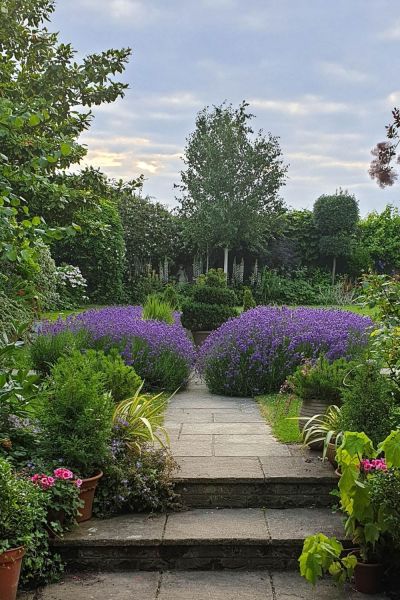
If we had planted the small borders around the central pot, we would have needed to look after them. This block planting of lavender is very easy-care.
What if the garden is completely overgrown?
If you’ve moved into a house where the garden seems completely overgrown, then the step-by-step method becomes even more important.
When Natalie and Mike Newman moved into their house, the garden had been designed in Victorian times. But it had been completely neglected for a year, and the house had been rented out for over decade. The lawn was thick with thistles and self-seeded trees.
They started by clearing the obviously overgrown areas and engaging tree surgeons to sort the trees. Those two steps gave them a chance to see what was worth keeping and what to do next. You can read about it in ‘where do you start with a neglected garden?’
Have a few larger pots rather than lots of little ones…
Pots are high maintenance. If you want easy-care pots, have a few large pots and fill them with easy-going evergreen shrubs. There’s more about this in my post on the best plants for amazingly low maintenance garden pots.
All you really need to do is to take them out of the pot and change the soil once a year, in spring. Then feed them a liquid fertiliser in the summer. I often let my pots go for a few years without changing the soil. Some are fine, but the phormiums are looking straggly.
You can save even more effort by incorporating a slow release fertiliser in spring. You’ll need to start feeding again in late summer, but that will give you some breathing space in the busy times.
Let yourself be overwhelmed by your garden – or parts of it!
I’ve just bumped into a friend who has cut her gardening tasks down by allowing half the garden to go wild. Do this carefully at first – if you just stop doing any gardening, your garden may just get overgrown with brambles.
Read up about gardening for wildlife and wilder gardens generally. Try Planting for Wildlife, a grower’s guide to re-wilding your garden, by Jane Moore.
I’m also turning two patches of front lawn into mini-meadows. I do regular updates on the Middlesized Garden YouTube channel with the monthly garden tips and tour videos. There are time-stamps in the descriptions below the videos, so you can jump straight to the mini meadow part.
You will need a lighter hand to rewild your garden, but don’t completely ignore what’s going on. Although I do have a friend who had a ten acre garden. She didn’t have the time, money or interest to look after it all. So she let about eight acres run to brambles and woodland, leaving the rest of it to lawn. We stood out on the lawn at her parties and never noticed that the trees were concealing so many brambles.
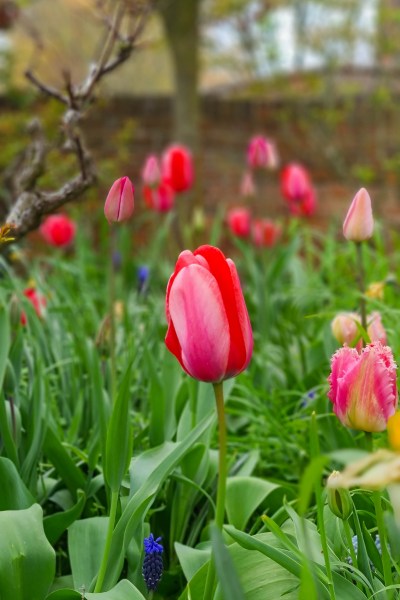
These tulips look rather beautiful in meadow grass in our front garden. However Jane Moore, author of Planting for Wildlife, says that meadow areas look best when properly defined. Also these roses (and the tulips) need a richer soil than a meadow does. So I am going to have borders, with a square of meadow lawn in the middle. For more meadow gardening tips, see the late spring garden tips and tour video on the Middlesized Garden YouTube channel.
No task is too small – beat garden overwhelm with small tasks
If you see a weed, pull it out there and then. Don’t wait until you have time to weed the whole border, even if you can see that other weeds are growing on the edge of your eyeline. If you constantly defer minor jobs, you’ll quickly get overwhelmed by your garden. There’s a no-nonsense guide to weeding your garden here, because weeding is a BIG task in spring.
Install an outdoor tap/s in convenient places so you can water easily
It’s a big investment but you won’t regret it. It will save you so much time rolling and unrolling hoses and getting kinks out. Or you could run to a proper irrigation system.
Do a daily inspection
The great gardeners, such as Christopher Lloyd, patrolled their gardens with a notebook. If you’re a notebook type, this is an excellent idea, but I would lose the notebook.
However, just patrolling each border and area every day, actively noting what is happening, makes a big difference to preventing you from being overwhelmed by your garden.
If you’re overwhelmed by your garden, get help but…
Sometimes you need help. And it’s better to get expert help for some jobs – for example, for trimming hedges and pruning trees – than to muddle along doing it yourself.
And it’s also good to look for regular paid help. But it’s important to remember that professional gardeners train for several years. They have to buy and maintain tools, pay tax and national insurance, they need year-round employment and they travel from job to job. This is not a minimum wage or school leaver job, unless you are so expert that you can ‘train’ a succession of youths wanting to go into gardening.
I’ve written a post about finding the perfect gardener for your garden.
Why you should avoid some of the garden overwhelm advice…
I have seen suggestions that if you are overwhelmed by your garden, then you should ask friends for help. This would work well as a swap – we’ll do my pots this week and your pots next week, for example. Or what about a skills swap (four hours of gardening for 2 evenings of baby-sitting?).
But otherwise, friends have their own houses and gardens to maintain. They may be feeling as overwhelmed as you are.
One friend of mine with a large garden in the countryside got divorced. Finding the garden too much for one person, she invited friends for country weekends on the basis that everyone would spend Sunday morning gardening. She soon worked out that some people hated gardening and that others just needed to relax at the weekend.
She eventually dealt with her garden overwhelm by moving to a house with a smaller garden. ‘It was either that or lose all my friends,’ she said. ‘People were very willing to help while I was going through the divorce, but no-one wanted it to be a long term solution.’
Let go of the concept of perfection…
Even the great gardens are not perfect. Even if you really are overwhelmed by your garden, that may mean you get some beautiful surprises as the garden itself takes over.
Shop my favourite gardening books, products and tools
I’ve put gardening books, products and tools that I use myself or which have been recommended by sources I trust into lists on the Middlesized Garden Amazon Store. For example, here are some wildlife friendly gardening books and products.
You can also buy a mug, t-shirts and tote bags with my favourite saying ‘Gardeners Learn By Trowel and Error’ from the Middlesized Garden Spring store.
Join us once a week for more gardening tips, ideas and inspiration
If you’d like to receive a weekly email with Middlesized Garden posts and videos, click here.
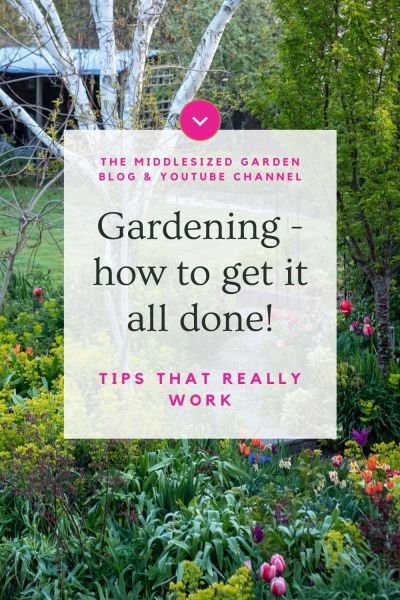

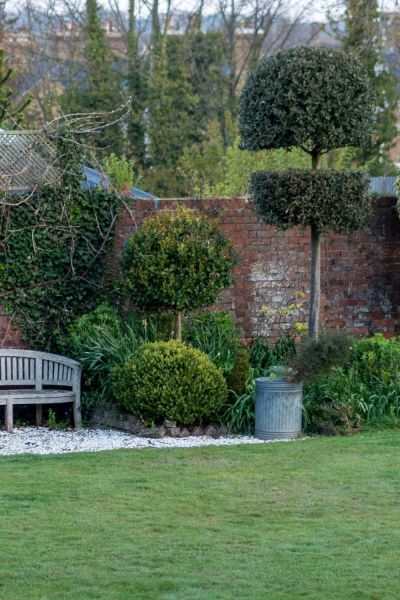























Many thanks for lots of useful tips I can apply to my own garden. Chunking jobs down into manageable sizes and the 15 minute rule is definitely the way for me to garden from now on. I am also planning to put baskets in several areas of the garden so that if i see a weed i can quickly pull it up and put it in the basket, a tip I picked up whilst visiting Yorke Gate, Leeds.
Thank you also for your advice sometime ago regarding writing a garden blog. I took your advice and am using the blog as a journal in which I can record things and look back and review my progress. Writing about and photographing my garden gives me so much pleasure especially as I have been unable to visit other gardens until recently.
So glad to hear it, thank you!
Love this post. One thing that helps me is asking myself WHY I want to do certain gardening jobs. I had no idea before I started asking myself this, that so much was about impressing others with the end result. As soon as I step out of this I seem to be able to create a “to not do” list and really be in the moment with what I really want to do.
That’s an excellent point! Thank you.
Thank you so much for this post Alexandra. Suddenly feeling a bit overwhelmed today with all the ‘to do’ tasks! Your gardening blog was the first I read, probably about 3 years ago and you have inspired me to dip into the online gardening world ….I love your enthusiasm and have learnt a lot from your blog. Gardening has always been an absolute and necessary joy to me and it is lovely to find a thriving gardening community out there. My instagram name is peaceandplentygarden, although I am still a newbie and finding my way. Last year our garden was accepted onto the NGS scheme although we decided to wait a year because of lockdown and also some work we wanted to do in the garden. Happy days! Thank you again for inspiring me, Helen
Thank you so much! And I hope you enjoy your NGS opening – I’ll check out your Instagram feed.
Excellent advice! I’ve found that chunking the tasks really helps. I have a builder’s bucket,which I aim to fill with weeds every day. In spring this is a five minute job,but keeps me in control. Another tip is to start working in a different area each time,so that the ‘sad corner ‘doesn’t creep up on you!
Two excellent pieces of advice (we definitely had a ‘sad corner’ until recently, although I can feel another one coming on as we shift all the clutter.)